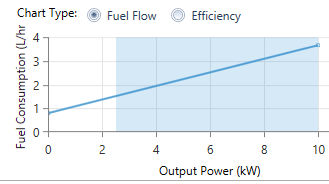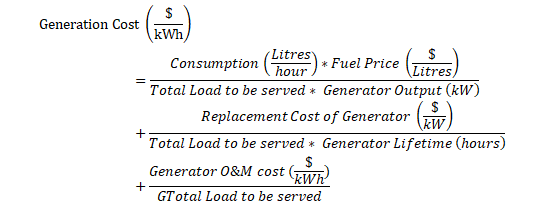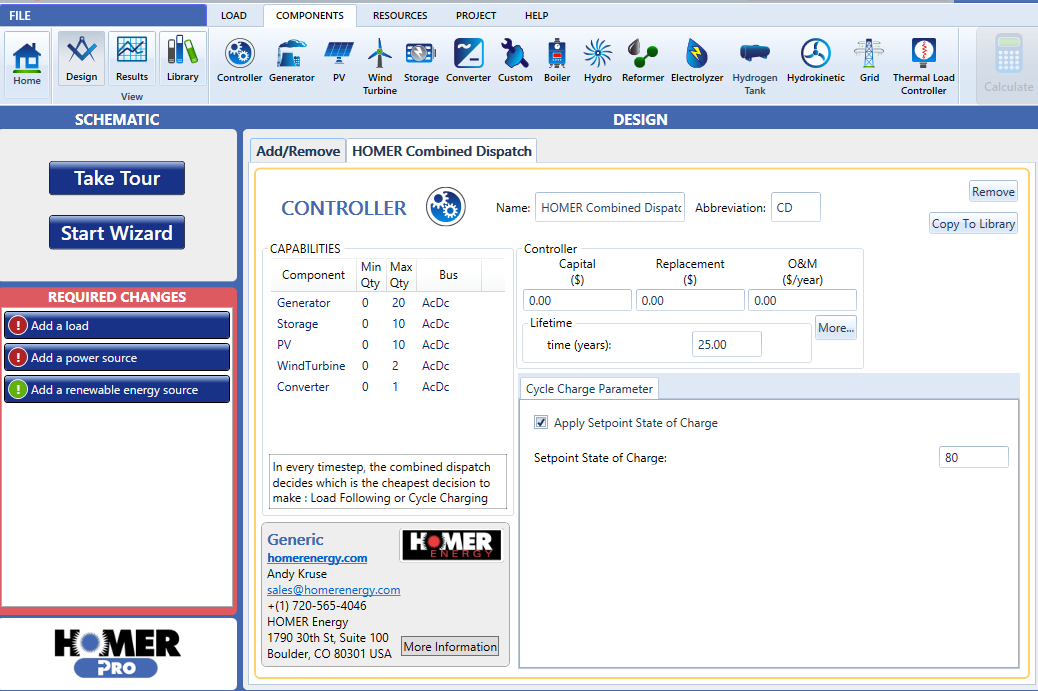
HOMER Pro 3.16

The Combined Dispatch strategy can improve performance over the Cycle Charging and Load Following dispatch strategies by making more efficient use of the generator.
Combined Dispatch versus Cycle Charging and Load Following
Both Cycle Charging and Load Following dispatch strategies make decisions in the current time step by making the following assumptions about the future load:
•By charging the battery using diesel, the Cycle Charging dispatch strategy adds more energy to the battery and makes it more likely that the generator can be turned off during future periods of low load.
•By not charging the battery using diesel, the Load Following strategy ensures that the generator can continue to be used during future periods of high load.
Each of these dispatch strategies works well if the assumptions are true.
To avoid making assumptions about the future net load, the Combined Dispatch strategy uses the current net load to determine whether to charge the battery using the generator. It uses the Cycle Charging dispatch strategy when the net load is low, and the Load Following dispatch strategy when the net load is high. By Cycle Charging during periods of low net load, the Combined Dispatch helps avoid using the generator at low loads. By Load Following during periods of high net load, the Combined Dispatch allows the continued use of the generator. Due to this flexibility based on high and low loads, the Combined Dispatch can perform better than Load Following or Cycle Charging in the energy access scenarios.
Combined Dispatch Strategy
Excess energy from renewable sources is always used to charge the battery if possible, but one of the fundamental decisions that the dispatch strategy must make is when to charge the batteries with energy from the generator.

When the generator is running, the marginal cost of increasing the output is substantially less than the average cost, which includes the costs that are independent of the power output. As a result of this cost function, there are potential savings from cycling generator energy through the battery if it prevents generator run time in the future. It can be less expensive to cycle generator power through the battery, incurring round-trip losses in the rectifier-battery-inverter and battery wear costs, if energy from the generator can be stored in the battery when the generator is already running.
In Cycle Charging, whenever the generator needs to be on to meet the net load (load minus renewable power), it is ramped to charge the battery to the maximum extent possible. In Load Following, the generator is dispatched only to meet the net load and serve any operating reserve requirements. In Load Following, battery charging is left to renewable sources and excess from forcing the generator to meet its minimum load constraint.
By charging the battery with diesel, the Cycle Charging dispatch strategy puts more energy in the battery and increases the likelihood that the generator can be turned off during future periods of low load. To avoid making assumptions about the future net load, the Combined Dispatch strategy uses the current net load to determine whether to charge the battery with the generator. It uses the Cycle Charging dispatch strategy when the net load is low and the Load Following dispatch strategy when the net load is high. By Cycle Charging during periods of low net load, it helps avoid using the generator at low loads. The following describes how HOMER switches between these two strategies.
To optimize the decision to serve the net load, the dispatch strategy must compare the cost of charging the battery using diesel from the generator with the cost of charging the battery only using excess power in the current time step. The net load is the load minus renewable generation. For the Cycle Charging and Load Following dispatch strategies, the net load can be served in three ways:
•Dispatch Decision 1: Net load is met fully by the battery alone.
•Dispatch Decision 2: Net load is met by a generator ramped up to charge the battery as much as possible.
•Dispatch Decision 3: Net load is met by a generator running at a power sufficient only to serve the load.
For each of the three options for satisfying the load, the dispatch strategy needs to calculate the cost of each possible decision. This cost includes expenses in the current time step and the expected value of any change in the battery stored energy. The Combined Dispatch strategy finds the least cost dispatch decision at every time step. The costs for each of the decisions are specified below:
•Dispatch Decision 1: The load is met fully by battery alone, which involves the cost of cycling through the battery.

•Dispatch Decision 2: The load is met by a generator ramped up to charge the battery as much as possible, which involves the cost of using the generator plus the cost of cycling through the battery.

•Dispatch Decision 3: The load is met by a generator running at a power sufficient to only serve load, which involves the cost of using the generator.

Combined Dispatch Scope
HOMER Pro users can use the Combined Dispatch strategy with a maximum of one Generator and multiple PVs, Wind, and Storage.
Using the Combined Dispatch Controller
On the Controller page, check the Apply Setpoint State of Charge: box and enter a percentage. The generators do not stop charging the battery bank until it reaches the specified state of charge.

Interpreting the Results of the Combined Dispatch Controller
A simulation using the Combined Dispatch as a Controller has the following time-series columns to interpret which dispatch strategy was used in a time step.
1.Zone
a.Zone = 1 for cycle charging
b.Zone = 2 for load following
c.Zone = 3 for Generator only
d.Zone = 4 for battery only
2.Cycle Charge Flag
a.Cycle Charge Flag = 1 if Cycle Charging started charging the battery in a previous time step and the battery is still below the SOC
b.Cycle Charge Flag = 0 if the above is not true
3.Cost of Cycle Charging
4.Cost to load follow
5.Cost of battery only
See also
